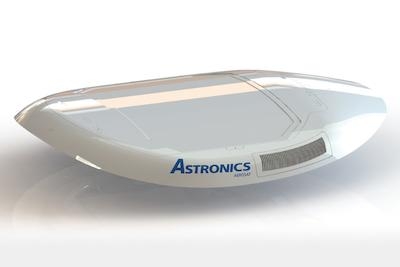Will Have New E-Series Designs On Display At Aircraft Interiors Expo
Astronics Corporation will preview its next-generation SATCOM connectivity solutions at the Aircraft Interiors Show (AIX) in Hamburg, Germany, from April 2-4, 2019. Developed by Astronics AeroSat, in conjunction with partner Phasor, the new SATCOM inflight connectivity antennas feature electronically steered array (ESA) technology that will deliver unprecedented connection reliability for aircraft.

Available in three configurations and with an ultra-low profile, the E-Series will provide Ku- and Ku-HTS connectivity for today’s geostationary Earth orbit (GEO) networks, as well as tomorrow’s medium Earth orbit (MEO) and low Earth orbit (LEO) networks. The system also will offer dual-beam capability, enabling it to support the future “make before break” requirement of non-GEO networks from a single array, or the ability to communicate with two independent GEOs or a LEO & GEO network simultaneously.
“We are creating some very exciting new technology with this product, and we believe the new E-Series will provide seamless connectivity for both new and existing networks while providing a true, solid-state, active array antenna system. This provides cost and reliability advantages for airlines, business and military aviation, satellite network operators, and most importantly, the passenger and their inflight connectivity experience,” explained Matthew Harrah, President of Astronics AeroSat.
“Phasor is very excited to be working with Astronics. Together we are providing the aviation industry with the best of both worlds – leading electronically steered antenna innovation coupled with best-in-class avionics and aeronautical SATCOM terminal integration expertise. We plan to deliver next-generation inflight connectivity across multiple airframe-types and satellite communications networks,” said David Helfgott, Phasor CEO.
Astronics’ E-Series antennas will feature Phasor’s active electronically steered array to provide maximum antenna performance. Unlike competing systems, the E-Series will feature technology that enables a simultaneous transmit and receive from a single antenna array, with no need for bulky extra panels that drive up costly size and weight. The system offers a flexible, modular architecture to serve a wide variety of aircraft types and applications:
- E-1000 model – will serve existing GEO constellations and is ready for LEO and MEO satellites for twin- and single-aisle commercial aircraft. This model measures 78” x 61” x 3.5”.
- E-600 model – a mid-size solution measuring 78” x 47” x 3.5”, intended to serve the same networks but targeted for single-aisle and business aviation aircraft.
- E-200 model – a small-size version, which is a future-concept antenna for LEO-only satellite networks that is ideal for turboprops up through twin-aisle commercial aircraft based on connectivity needs.
- Custom Configurations – due to the modular nature of Phasor’s proprietary technology that allows for additional installation options, custom systems can be configured based on the application and customer requirements, to include conformal “flush” mounting integrated into the fuselage.
Additional features of these antennas include:
- Suitability for both civilian and military aircraft
- Designed to withstand harsh weather environments, de-icing fluid, and reduced aerodynamic impact on other antennas and fuselage structures
- Hybrid network and satellite constellation support for future mixed (LEO/MEO/GEO) satellite networks
- Extremely low profile, <4” in height, reducing drag
- Ability to conform to the aircraft fuselage to optimize aerodynamics and high latitude operational performance
- 100% solid-state ESA, with no moving parts, to improve mechanical reliability
- ARINC 791/792 mounting compliance
Astronics will display the prototypes of these new inflight connectivity antenna systems at AIX to generate customer and industry feedback. Technology demonstrations of the inflight performance will occur in early 2020, with STC/PMA authorizations expected by 2021.
(Image provided with Astronics news release)
 ANN's Daily Aero-Term (04.28.24): Airport Marking Aids
ANN's Daily Aero-Term (04.28.24): Airport Marking Aids Aero-News: Quote of the Day (04.28.24)
Aero-News: Quote of the Day (04.28.24) ANN's Daily Aero-Linx (04.28.24)
ANN's Daily Aero-Linx (04.28.24) Aero-News: Quote of the Day (04.29.24)
Aero-News: Quote of the Day (04.29.24) ANN's Daily Aero-Linx (04.29.24)
ANN's Daily Aero-Linx (04.29.24)



